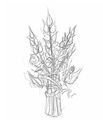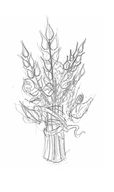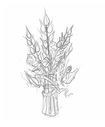The Naked Pint (52 page)
Authors: Christina Perozzi

FERMENTATION TEMPERATURE
65-80°F
PRIMING SUGAR
0.5 pound corn sugar dissolved in 1 cup boiling water and cooled to
room temperature
room temperature
In a small pot, heat 3 or 4 quarts of water to around 150°F (bubbles start to form on the bottom). Remove from the heat, and stir in the specialty grains. Cover and steep for 20 to 30 minutes.
Meanwhile, fill a large brewpot half full with water, and heat until bubbles start to rise from the pot. Turn off the heat, and stir in the malt extract.
After the grains have steeped, pour the liquid and grains through a strainer directly into the main brewpot. Add some hot water to the small pot, and rinse the grains in the strainer in the hot water to extract as much flavor and sugar as you can from the grains. This is the sparging process. Add this liquid to the main pot.
Bring what is now called wort to a full, rolling boil. Watch for boilovers! Once the foaming stops, add the contents of the first hop package, and set the timer for 45 minutes.
Meanwhile, sanitize your fermenter, strainer, airlock, and stopper.
When the timer sounds, add the second addition of hops, and set the timer for 15 minutes. When the timer sounds, add the last hop addition and turn off the heat.
When the boil is done, cool the pot in a sink until the sides are cool to the touch.
Pour the wort into the sanitized fermenter, add prechilled water to bring it up to 5 gallons at about 75°F, and pitch the yeast.
Ferment in the recommended temperature range for 7 to 10 days or until bubbling in the airlock has decreased to about one bubble a minute.
Bottle with dissolved priming sugar when fermentation is complete. (See Step Ten and Step Eleven on page 224.)
Sunset Boulevard Amber Ale: American Amber AleThis is Culver City Home Brewing’s version of the style that’s a staple of brewpubs and microbrews around the country. The use of Munich malt extract lends it a malty flavor, which is nicely balanced by a restrained hoppiness.
SPECIALTY GRAIN BILL
2 ounces chocolate malt
12 ounces British Crystal 77
4 ounces Crystal 40
12 ounces British Crystal 77
4 ounces Crystal 40
MALT SOURCE
6 pounds Munich malt extract
HOPPING SCHEDULE
1. 0.35 ounce Summit (16.7%) hops, boil 60 minutes
2. 0.4 ounce Willamette hops, add after 45 minutes
3. 0.6 ounce Crystal hops, add at 60 minutes
YEAST
White Labs WLP051 California V/Wyeast 1272 American Ale II or
Wyeast 1056 American Ale/White Labs WLP001 California Ale
Wyeast 1056 American Ale/White Labs WLP001 California Ale
FERMENTATION TEMPERATURE
65-75°F
PRIMING SUGAR
0.5 pound corn sugar dissolved in 1 cup boiling water and cooled to
room temperature
room temperature
In a small pot, heat 3 or 4 quarts of water to around 150°F (bubbles start to form on the bottom). Remove from the heat, and stir in the specialty grains. Cover and steep for 20 to 30 minutes.
Meanwhile, fill a large brewpot half full with water, and bring to a boil.
When bubbles start to rise from the pot, turn off the heat and stir in the malt extract.
After the grains have steeped, pour the liquid and grains through a strainer directly into the main brewpot. Add some hot water to the small pot, and rinse the grains in the strainer in the hot water to extract as much flavor and sugar as you can from the grains. This is the sparging process. Add this liquid to the main pot.
Bring what is now called wort to a full, rolling boil. Watch for boilovers! Once the foaming stops, add the contents of the first hop package, and set the timer for 45 minutes.
Meanwhile, sanitize your fermenter, strainer, airlock, and stopper.
When the timer sounds, add the second addition of hops, and set the timer for 15 minutes. When the timer sounds, add the last hop addition and turn off the heat.
When the boil is done, cool the pot in a sink until the sides are cool to the touch.
Pour the wort into the sanitized fermenter, add prechilled water to bring it up to 5 gallons at about 75°F, and pitch the yeast.
Ferment in the recommended temperature range for 7 to 10 days.
When the bubbling in the airlock is down to less than twice a minute, move the beer to a secondary fermenter. This can be another bucket or glass carboy. This allows the beer more time to ferment and adds another layer of complexity to the flavor profile before bottling.
Bottle with dissolved priming sugar when the fermentation is complete.

W
e are big fans of Allagash brews, and have been fortunate enough to share pints with Rob and pick his brain on beer-related subjects. His interest in brewing began in the early 1990s when he worked for Otter Creek Brewery in Vermont. Through Rob’s travels, he had sampled many styles of beer and was struck by the inventiveness and depth of Belgian beers. Though Belgian styles were scarcely heard of in the United States at the time, Rob saw this as an open niche in the micro-brewery market. In 1995, Rob founded Allagash Brewing Company and began his venture with the release of his award-winning flagship, Allagash White. Since then, Allagash has added a number of beers to its portfolio, including a barrel-aged series, a series of philanthropic beers, and a series that uses Allagash’s own proprietary
Brettanomyces
yeast strain.
Tripele are big fans of Allagash brews, and have been fortunate enough to share pints with Rob and pick his brain on beer-related subjects. His interest in brewing began in the early 1990s when he worked for Otter Creek Brewery in Vermont. Through Rob’s travels, he had sampled many styles of beer and was struck by the inventiveness and depth of Belgian beers. Though Belgian styles were scarcely heard of in the United States at the time, Rob saw this as an open niche in the micro-brewery market. In 1995, Rob founded Allagash Brewing Company and began his venture with the release of his award-winning flagship, Allagash White. Since then, Allagash has added a number of beers to its portfolio, including a barrel-aged series, a series of philanthropic beers, and a series that uses Allagash’s own proprietary
Brettanomyces
yeast strain.
Rob says: This is a Belgian-style Tripel that usually ends up at 9% ABV. This Tripel can push the traditional style guidelines a little bit, depending on the yeast selection.
The yeast strain a brewer chooses is critical to the overall character of the beer, especially with Belgian-style beers! The simple malt and hop components of this recipe allow the yeast to express itself; we use this same concept at Allagash for our Tripel.
The sugar addition raises the specific gravity of the beer (and the alcohol content) without adding sweetness. It is essentially 99% fermentable by the yeast, so no residual sweetness or body remains from the sugar after fermentation. Use a Belgian candi sugar, a readily available cane sugar, or rock candy (all are sucrose).
It is important to use a Belgian yeast strain for this recipe. The traditional yeast would be an Abbey strain. Most homebrew shops will have one of these strains. You can also push the style guidelines of this beer by fermenting it with a Belgian Strong Golden Ale yeast, or even a Belgian Wit yeast. Try brewing this recipe with different strains of yeast, and you will end up with beers that have markedly different character.
MALT EXTRACT
9 pounds Light/Pilsen malt extract
HOPPING SCHEDULE
1. 1.5 ounces Hallertauer hops (bittering), boil 60 minutes
2. 0.25 ounce Saaz hops (taste), add after 60 minutes
3. 0.25 ounce Saaz hops (aroma), add at 75 minutes
2. 0.25 ounce Saaz hops (taste), add after 60 minutes
3. 0.25 ounce Saaz hops (aroma), add at 75 minutes
YEAST
Wyeast 1214 Belgian Abbey or Wyeast 1388 Belgian Strong or Wyeast
3944 Belgian Wit
3944 Belgian Wit
FERMENTATION TEMPERATURE
65-75°F
PRIMING SUGAR
1.25 pounds sugar dissolved in 1½ cups boiling water and cooled to
room temperature
room temperature
In a brew kettle, heat 6 gallons of water to a boil. Remove from the heat, and add the malt extract. Return to a boil.
After 15 minutes, add the Hallertauer hops, and boil 60 minutes. Add the first Saaz hops, and boil 15 minutes. Remove from the heat, add the remaining Saaz hops, swirl the contents of the kettle to create a whirlpool, and allow to rest for 15 minutes.
Cool the wort and rack (move) to your fermenter, leaving as much of the solids behind in the kettle as possible. Use a strainer if you can.
Once the wort is at 75°F or below, pitch the yeast, and ferment at the recommended temperature.
Add your dissolved priming sugar dose, and bottle when fermentation is complete.


e
P
atrick Rue is one of the brewers and owners of the Bruery in Orange County, Californina, who found his true calling in making beer rather than being a lawyer. The Bruery is spelled so because of Patrick’s last name and because it is a family-run business. The Bruery specializes in Belgian-style ales crafted with a distinctive twist. All of its beers are 100% bottle-conditioned, meaning the beers undergo fermentation in the bottle, which allows a complexity of flavor to arise. We are inspired by Patrick’s use of interesting flavorings, like Thai basil and lavender. His creations step outside the norm and give our palates something to ponder.
P
atrick Rue is one of the brewers and owners of the Bruery in Orange County, Californina, who found his true calling in making beer rather than being a lawyer. The Bruery is spelled so because of Patrick’s last name and because it is a family-run business. The Bruery specializes in Belgian-style ales crafted with a distinctive twist. All of its beers are 100% bottle-conditioned, meaning the beers undergo fermentation in the bottle, which allows a complexity of flavor to arise. We are inspired by Patrick’s use of interesting flavorings, like Thai basil and lavender. His creations step outside the norm and give our palates something to ponder.
One of our favorite Bruery beers is Black Orchard, which is a traditional Belgian Wit made untraditionally with chocolate malt. That combination is quite a unique experience. For the following recipe, Patrick turns the tables on a traditional Saison by using a darker malt, like those used for Dunkel styles. The ABV should end up at around 7.8%.
Saison NoirEnjoy this dry, fruity, complex ale!
e
SPECIALTY GRAIN BILL e
1 pound Weyermann Dehusked Carafa III
MALT SOURCE 3
7 pounds light dried malt extract
HOPPING SCHEDULE
0.5 ounce German Hallertauer Magnum Pellet (11%) hops,
boil 60 minutes
boil 60 minutes
OTHER INGREDIENTS
1 pound Buckwheat honey
0.25 ounce dried spearmint (bagged), add at end of boil
0.25 ounce dried chamomile (bagged), add at end of boil
0.25 ounce dried spearmint (bagged), add at end of boil
0.25 ounce dried chamomile (bagged), add at end of boil
YEAST
White Labs WLP565 Belgian Saison I Ale
Wyeast 5112
Brettanomyces bruxellensis
Wyeast 5112
Brettanomyces bruxellensis
PRIMING SUGAR e
4 ounces cane sugar dissolved in ½ cup boiling water and cooled to
room temperature
room temperature
Add the grain to a steeping bag, and steep cold in a kettle or pot with 5.5 gallons of water for 20 minutes.
Remove the grain. Bring the water to a boil, and remove from the heat. Add the malt extract, and stir well until dissolved. Add the hops.
Bring to a boil, and boil 60 minutes. Remove from the heat, and add the honey. Mix well. Add the spearmint and chamomile, and let sit 5 minutes.
Chill the wort as cold as possible, preferably to 50°F. Pitch the Belgian Saison yeast.
Let the fermentation temperature naturally rise as high as possible, preferably to 90°F to 95°F. This temperature will be reached after about 2 days of fermentation. If the beer doesn’t get warm enough, wrap the fermenter with a towel to tr y to retain heat.
Other books
The Weaver Fish by Robert Edeson
The Blood Lie by Shirley Reva Vernick
Dark Valley Destiny by Unknown
The Night Ranger by Alex Berenson
You & Me Make Three: Barrington Billionaire's Series: Book Three by Jeannette Winters
Pulse 2 (Pulse Series) by Rhea Wilde
Sleeping Beauty by Judith Ivory
Ain't It Time We Said Goodbye by Robert Greenfield
Suddenly Royal by Nichole Chase
A Family for Christmas by Noelle Adams
